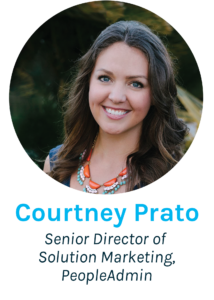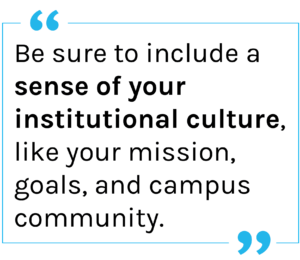Developing an employment brand is key to attracting talent in a competitive market.

As colleges and universities increasingly compete for talent with the corporate sector, we can no longer rely on the traditional talent pipeline. It’s important that hiring teams start adopting recruitment marketing techniques, including building an employment brand.
Since many institutional names and the historical draw of a HigherEd role no longer carry the same weight for many job-seekers, attracting talent now requires active marketing of your institution as an employer—or developing an employment brand. Below, hear from PeopleAdmin expert Courtney Prato about best practices for building an employment brand.
 Why do we need an employment brand?
Why do we need an employment brand?
An employment brand is the identity and messaging that an organization communicates to potential candidates, usually encompasses an organization’s culture, mission, values, and work environment. For HigherEd, this can be similar to an institutional brand – but should be distinct.
“In 2023, HigherEd institutions should focus on developing an employment brand that is separate and distinct from the institutional brand that is used to drive student enrollment. Institutions can no longer rely on their student enrollment brand in the talent marketplace in drive applications the way it has in the past,” says Courtney Prato, Senior Director of Solution Marketing at PeopleAdmin.
“For instance, CUPA-HR research has shown that most people under the age of 25 have a poor perception of the culture and compensation in HigherEd. The biggest way to combat these perception issues is to develop an employee value proposition, or EVP. This needs to be a unique differentiator that is consistently communicated throughout your talent cycle. In a recent webinar that we hosted at PeopleAdmin, we polled attendees from HigherEd institutions across North America and found that 65% do not have any separate or distinct employment brand. Developing an EVP at your institution will put you on the cutting edge of recruitment marketing today.”
Best practices for creating an EVP
According to PeopleAdmin research, an employee value proposition is multi-dimensional and has some key central components.
“The first thing to think about including in your EVP is compensation and benefits—this includes everything from time off, to holidays, health insurance, and retirement plans,” says Courtney. “Institutions should also include information about career longevity and stability – training, growth, and professional development opportunities – and descriptions of the work environment, including opportunities for recognition, levels of autonomy, and work-life balance. As remote and hybrid work has become more common, it’s important to include information about work location and flexible work policies. In addition, be sure to include a sense of your institutional culture, like your mission, goals, campus community, leadership initiatives, and how that all comes together to make your institution a unique and desirable place to work.”
Dive in now!
Use the tips above as a template to start designing your own institutional employer brand and EVP. With a clearly defined and well-communicated employee value proposition, you’ll be better able to attract and compete for top talent. Check out our solutions for HR for more!